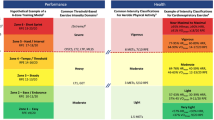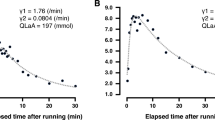Abstract
The authors studied changes in the hemostasis system while working on bicycle ergometer with and without manifest fatigue. The direction and value of the change in blood coagulation time and natural lysis of a blood clot under the influence of exercise correlated with the initial state of the system. Work mostly inhibited blood coagulation when its initial values high and accelerated it when they were low. When fibrinolytic activity of blood at rest was low, it was stimulated; when it was high, it was inhibited. A similar relation between the initial values and response to exercise characterized several indices of the plasma link of hemostasis, such as plasma coagulation time, fibrinogen concentration, activity of antithromboplastins and antithrombin III, and euglobulin clot lysis time. Fatigue led to more manifest individual changes in most of the indices of coagulant, anticoagulant, and fibrinolytic activity of blood. As a rule, the value of correlation between the initial state and changes in the indices increased. This suggests strengthening of the role of the initial state in the hemostasis system response to exercise.
Similar content being viewed by others
REFERENCES
Golyshenkov, S.P., Importance of Initial State in the Adaptation of the Hemostatic System to Muscular Activity, in Fiziologicheskie i biokhimicheskie problemy adaptatsii (Physiological and Biochemical Problems of Adaptation), Voprosy mediko-biologicheskikh nauk (Problems of Medico-Biological Sciences), Saransk, 1998, no. 3, p. 7.
Golyshenkov, S.P., Ivenina, G.V., Tairova, M.R., and Lapshina, M.V., Role of Initial State of the Hemostatic System in the Response of Coagulation and Fibrinolysis to Exercise, Fiziol. Chel., 1999, vol. 25, no. 5, p. 92.
Andreenko, G.V., Fibrinoliz (biokhimiya, fiziologiya, patologiya) (Fibrinolysis: Biochemistry, Physiology, Pathology), Moscow: Mosk. Gos. Univ., 1979.
Arnesen, H., Akesson, I., Stromme, S.B., et al., Fibrin- Fibrinogen Degradation Products (FDP) in Urine and Serum after Prolonged Heavy Exercise, Scand. J. Hae-motol., 1976, vol. 16, no. 4, p. 279.
Korytko, Z.I., Role of the Thrombin-Plasmin System in the Structural-Functional State of the Myocardium under Conditions of Physical Overloads, Abstract of Cand. Sci. (Biol.) Dissertation, Lvov, 1990.
Lee, R.J. and White, P.D., A Clinical Study of Coagulation Time of Blood, Am. J. Med. Sci., 1913, vol. 145, p. 495.
Beller, F.K. and Graeff, H., Clotting Time Technics, in Thrombosis and Bleeding Disorders: Theory and Methods, Stuttgart, 1971, p. 65.
Barkagan, Z.S., Issledovanie sistemy gemostaza v klinike: Metodicheskie ukazaniya (Clinical Study of the Hemostatic System: Methodological Instructions), Barnaul, 1975.
Rutberg, R.A., A Simple and Rapid Method of Simultaneous Determination of Recalcification Time and Fibrin-ogen Concentration, Lab. Delo, 1961, no. 6, p. 6.
Rudzevich, E.L. and Byshevskii, A.Sh., Determination of Antithromboplastins with Momental and Progressive Effect in Human Blood Serum, Kazan. Med. Zh., 1976, vol. 57, no. 5, p. 462.
Hensen, A. and Loeliger, E.A., The Influence of Anti-thrombin III on Blood Coagulation in vitro, Thrombos. Diathes. Haemorrh., 1963, vol. 9, no. 1, p. 53.
Abildgaard, U., Graven, G., and Godal, U.C., Assay of Progressive Antithrombin in Plasma, Thrombos. Diathes. Haemorrh., 1970, vol. 24, no. 1/2, p. 224.
Beaumont, J.L., Nouvelle methode de docage de l'heparin dans le sang et les humeurs (1), Sang, 1953, vol. 24, p. 478.
Kotovshchikova, M.A. and Kuznik, B.I., A Simple Method of Determination of Natural Lysis and Blood Clot Retraction, Lab. Delo, 1962, no. 5, p. 6.
Golyshenkov, S.P., Methodology of Determination of Euglobulin Clot Lysis Time and Contact Activation Range Index, in Eksperimental'nye issledovaniya prot-sessov adaptatsii (Experimental Studies of Adaptation Processes), issue 5 of Voprosy mediko-biologicheskikh nauk (Problems of Medico-Biological Sciences), Saransk, 2000, p. 64.
Kovalenko, A.P., Additional Capacities of the Standard Fibrin Plate Method, Lab. Delo, 1980, no. 10, p. 615.
Nanniga, L.B. and Guest, M.M., Preparation and Properties of Anticoagulant Split Product of Fibrinogen and Its Determination in Plasma, Thrombos. Diathes. Haemorrh., 1967, vol. 17, no. 3-4, p. 440.
Kudryashov, B.A., Lyapina, L.A., and Grigor'eva, E.A., Interaction of Heparin with Fibrinonomer and Finrino-mer- Fibrinogen Complex, Vopr. Med. Khim., 1980, vol. 26, no. 8, p. 318.
Kudryashov, B.A., Lyapina, L.A., Zhitnikova, E.S., and Obraztsov, V.V., Formation of Adrenaline-Heparin- Fibrinogen Secondary Complex and Its Properties, Vopr. Med. Khim., 1975, vol. 21, no. 1, p. 65.
Warren, J.B., Dalton, N., Turner, C., et al., Adrenaline Secretion during Exercise, Clin. Sci., 1984, vol. 66, no. 1, p. 87.
Zubairov, D.M. and Popova, L.G., New Evidence for the Activation of Factor XII by epinephrine, Thromb. Res., 1976, vol. 8, no. 5, p. 587.
Lyapina, L.A., Zhitnikova, E.S., and Kudryashov, B.A., Lysis of Fresh Experimental Thrombs under the Impact of Adrenaline-Heparin-Fibrinogen Secondary Complex, Farmakol. Toksikol., 1978, vol. 41, no. 1, p. 82.
Kudryashov, B.A., Lyapina, L.A., and Ul'yanov, A.M., Importance of the Adrenaline-Heparin-Fibrinogen Secondary Complex in Fibrinolytic Activity of Euglobulin Blood Fraction after Intravenous Administration of Thrombin and Plasmin, Vopr. Med. Khim., 1978, vol. 24, no. 2, p. 255.
Nillson, I.M., Plasminogen Activator Release Assays, Acta Clin. Belg., 1977, vol. 32, no. 6, p. 391.
Marsh, N. and Gaffney, P., Some Observations on the Release of Extrinsic and Intrinsic Plasminogen Activators during Exercise in Man, Haemostasis, 1980, vol. 9, p. 238.
Meerson, F.Z. and Pshennikova, M.G., Adaptatsiya k stressornym situatsiyam i fizicheskim nagruzkam (Adaptation to Stressor Situations and Exercises), Moscow: Meditsina, 1988.
Shimamoto, T. and Ishioka, T., Release of a Thromboplastic Substance from Arterial Walls by Epinephrine, Circul. Res., 1963, vol. 12, no. 2, p. 138.
Byshevskii, A.Sh., Galyan, S.L., and Shapovalov, P.Ya., Mechanisms of Connection between Hemostasis and Lipid Peroxidation, in V Vserossiiskaya konferentsiya “Trombozy, gemorragii, DVS-sindrom: Problemy lech-eniya” (V All-Russ. Conf. “Thromboses, Hemorrhages, DIC Syndrome: Problems of Treatment), Moscow, 2000, p. 145.
Kitaguchi, H. and Izaki, S., A Physiological Study on the Releasing Mechanism of Plasminogen Activator from the Vascular Wall, Thrombos. Diathes. Haemorrh., 1975, vol. 34, no. 1, p. 351.
Lapshina, M., Relation of Lipid Peroxidation Indices to Fibrinolytic Activity of Erythrocytes. in Issledovaniya adaptatsionnykh protsessov (Studies on Adaptation Processes), issue 6 of Voprosy mediko-biologicheskikh nauk (Problems of Medico-Biological Sciences), Saransk, 2001, p. 25.
Author information
Authors and Affiliations
Rights and permissions
About this article
Cite this article
Golyshenkov, S.P., Tairova, M.R. Role of the Initial State in the Response of the Hemostasis System to Heavy Exercise. Human Physiology 28, 470–476 (2002). https://doi.org/10.1023/A:1016542201476
Issue Date:
DOI: https://doi.org/10.1023/A:1016542201476




